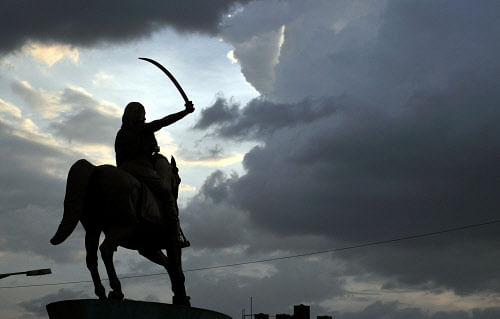
As India enters its 73rd year of independence, the country is all set for its second biyearly descent into the memory lane to recall the freedom struggle, the gallant freedom fighters who fought it and their stories sprawled all over the history books.
It is only when one digs deeper that one realises that the books overlooked a couple of valiant women -- some natively revered, some working under the radar.
Here's a look at some from Karnataka that aren't the first ones to come to mind when you hear 'Indian freedom struggle,' the tales of the locally celebrated heroes that call for a wider audience:
Rani Abbakka Chowta: Abbakka Chowta, the Queen of Ullal, was amongst the first female rulers to fight a fierce war to safeguard her kingdom from European invaders -- in her case the Portuguese. Her story dates back to 1555.
Over a century before the British set foot in India, the Portuguese had already begun making advances, building forts and capturing territories on the western coast, and were eyeing Abbakka's Ullal, a strategic and thriving port location in present-day Mangalore.
The defiant Abbakka refused to give in to the Portuguese forces trying to extort through numerous demands for tribute. An exasperated Portuguese force, under Admiral Dom Álvaro da Silveira in 1555, attacked Ullal, only to be repealed by Abbakka and her army. Many attacks from the Portuguese followed that were subsequently quashed by the valiant queen and her forces until the 1568 attack where they successfully captured Ullal. It is said that the final defeat came as a result of Abbakka's estranged husband joining forces with the Portuguese.
Ullal and certain parts of Karnataka celebrate the ‘Veera Rani Abbakka Utsava,' a festival celebrating her gallantry, every year.
Rani Chennamma of Kittur: The queen of Kittur, a princely state in present-day Belgaum, Rani Chennamma was one of the first female fighters to rise in revolt against the British governance. She led an armed rebellion against the British in 1824, long before we saw the entry of Rani Lakshmibai in the first war of independence, the1857 uprising.
The revolt came as a result of the British attempt to annex Kittur citing the Doctrine of Lapse. They had ordered the expulsion of Chennamma's adopted child, Shivalingappa, the heir to the throne after the death of Chennamma's biological son with Raja Mallasarja of the Desai family. Chennamma refused to give in, starting with a fight against a force of around 20,000 men and 400 guns that attacked the Kittur fort, fighting many battles the followed alongside her trusted lieutenants Sangolli Rayanna and Gurusiddappa, a quest that ended with her ultimate arrest and imprisonment as a political prisoner.
Kittur Utsav, a three-day cultural event, is celebrated even today to pay homage to the queen.
In her honour, on 11 September 2007, a statue of Kittur Rani Chennamma was unveiled at the Parliamentary Building in New Delhi by Pratibha Patil, the first woman President of India.
Apart from the two valiant Ranis who are way ahead of their times, Karnataka also saw several other contemporary women Satyagrahis that spearheaded the movement in the state.
Dharwad's Bellary Siddamma, for instance, was one of the few women who were arrested following the unfurling of the national flag during the Shivapura Dhwaja Satyagraha (flag satyagraha) 1938, a major turning point for the freedom movement in Karnataka. It is also said that she was the first lady to be arrested by the Mysore state police for her participation in the movement.
Siddamma is just one such name. Staunch Gandians like Hubli's Umabai Kundapur, Mangaluru's Kamaladevi Chattopadhyay, Jayadevi Tayi Ligade, Honnavar's Krishnabai Panjikar, Bengaluru's Yashodhara Dasappa, Subbamma Jois, Nagamma Veeranagouda Patil, among so many others don't find a place in the books at all.
In their case, along with spreading Gandhi's message across Karnataka and mobilising people to join the movement, most of them also worked towards the larger cause of emancipation of women in the state, something that they continued doing even after 15th August, 1947.